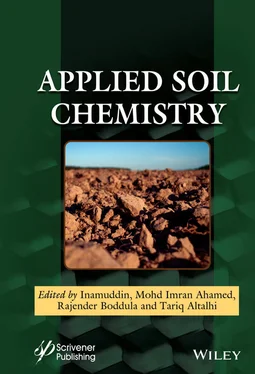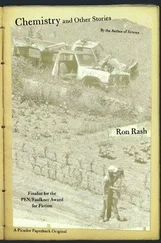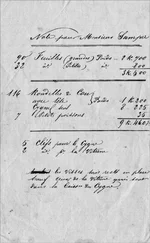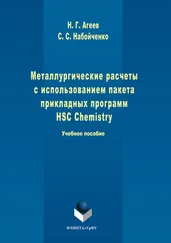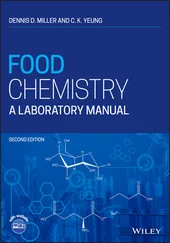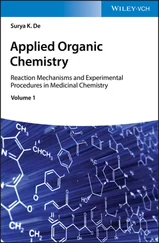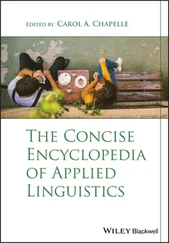Applied Soil Chemistry
Здесь есть возможность читать онлайн «Applied Soil Chemistry» — ознакомительный отрывок электронной книги совершенно бесплатно, а после прочтения отрывка купить полную версию. В некоторых случаях можно слушать аудио, скачать через торрент в формате fb2 и присутствует краткое содержание. Жанр: unrecognised, на английском языке. Описание произведения, (предисловие) а так же отзывы посетителей доступны на портале библиотеки ЛибКат.
- Название:Applied Soil Chemistry
- Автор:
- Жанр:
- Год:неизвестен
- ISBN:нет данных
- Рейтинг книги:5 / 5. Голосов: 1
-
Избранное:Добавить в избранное
- Отзывы:
-
Ваша оценка:
- 100
- 1
- 2
- 3
- 4
- 5
Applied Soil Chemistry: краткое содержание, описание и аннотация
Предлагаем к чтению аннотацию, описание, краткое содержание или предисловие (зависит от того, что написал сам автор книги «Applied Soil Chemistry»). Если вы не нашли необходимую информацию о книге — напишите в комментариях, мы постараемся отыскать её.
Applied Soil Chemistry — читать онлайн ознакомительный отрывок
Ниже представлен текст книги, разбитый по страницам. Система сохранения места последней прочитанной страницы, позволяет с удобством читать онлайн бесплатно книгу «Applied Soil Chemistry», без необходимости каждый раз заново искать на чём Вы остановились. Поставьте закладку, и сможете в любой момент перейти на страницу, на которой закончили чтение.
Интервал:
Закладка:
2.2.2 Coarsely Grinded Minerals
According to Goldich et al ., in the year 1938 [31–33], stability sequence of coarsely grained minerals was reported as (most stable first) quartz, muscovite, orthoclase, plagioclase, biotite, amphibole, and pyroxene. Marel et al ., in the years 1949, 1948a, and 1947 [34–36] reported magmatic minerals stability, keeping the particle size and weathering conditions similar (most resistant first), quartz, tourmaline, rutile, staurolite, zircon, allanite, albite, microcline, orthoclase, garnet, muscovite, oligodase, andesine, bytownite, epidote, anorthite, ampjibole, augite, biotite, hypersthene, olivine, and volcanic glass. As coarsely grinded quartz is not susceptible toward weathering, it is considered as stable among all the minerals.
2.2.3 Clay Size Mineral Particles
When the size of the particles of mineral becomes finer, then the sequence of stability of mineral becomes different relative to the coarsely grinded particle of mineral. This happens due to the enhancement of specific surface which increases the process of mineral weathering, which was comparatively more stable in coarsely grinded particle size. The particle size of clay minerals is below 200 diameters. According to Jackson et al ., in the year 1948 and 1952 [37–39], the sequence of weathering consisted of 13 stages for clay size particles. The sequence is in descending order of stability:
Anatase (corundum, leucoxene, ilmenite, rutile, zircon, etc.)
Hematite (limonite, goethite, etc.)
Gibbsite (also allophane, boehmite, etc.)
Kaolinite
Montmorillonite (also saponite, beidellite, etc.)
Vermiculite and silicates interstratified 1:2 layer
Muscovite (also illite, sericite, etc.)
Quartz
Albite (also orthoclase, microline, stilbite, anorthite, etc.)
Biotite (also nontronite, antigorite, magnesium chlorite, glauconite, etc.)
Olivine-hornblende (also diopside, pyroxenes, etc.)
Calcite (also apatite, aragonite, dolomite, etc.)
Gypsum (also ammonium chloride, sodium nitrate, halite, etc.)
There are few modifications in the above list. Apatite was included at calcite stage; allophane was included in gibbsite stage by Tamura et al ., in the year 1953 [40–42]. Marel et al ., in the year 1947, and Haseman and Marshall, in the year 1943 [43–45], included zircon in Anatase stage. Woof and Carroll et al ., in the year 1951 [46–48], and Marsden and Tyler, in the year 1938 [49–51], included leucoxene in the Anatase stage.
2.3 Factors Affecting the Rate of Chemical Weathering
The rate of reaction involved in a chemical weathering is under the control wide range of capacity and intensity factors, acting as function of integration of capacity, intensity, and time. The weathering time can give rise to stage or degree of weathering. The various driving force affecting the rate of reaction involved in chemical weathering can be recognized to a extent of consideration for formation of soil are five usual factors including, time, parent material, relief, biotic forces, and climate. The conditions affecting the reaction rate of chemical weathering needs to be analyze more specifically in categories other than above listed five factors for formation of soil. Leaching effect is included in single intensity factor whether it is under the control of internal drainage, relief, rate of evaporation, distribution of rainfall, and amount of rainfall. The extent as well as the nature of leaching is collectively significant for determining the process of chemical weathering. Reduction and oxidation are specifically considered whether controlled by valence of the ions in the minerals, texture of the material, etc.
2.3.1 Capacity Factors Which Controls the Reaction Rate of Chemical Weathering
2.3.1.1 Specific Surface Role
The higher the specific surface area of the targeted mineral, the finer the size of the particle and hence very speedily it gets affected by chemical weathering processes as reported by Polynov et al ., in the year 1937 [5], and Merrill et al ., in the year 1906 [2]. The enhancement of the specific surface is inversely proportional to the material particle diameter. It has been reported that sequence of weathering are different in case of particle with fine size in comparison to that of coarsely sized particles. For example, due to effect of specific surface the rate of weathering of volcanic ash is faster in comparison to lava. This happens due to the larger surface area subjected for processes for weathering.
2.3.1.2 Specific Weatherability Role of Mineral
According Jackson et al ., in the year 1948 [37], it was reported that the chemical weathering rate is dependent on the mineral specific nature. Minerals specific nature is highly significant for determination of rate and course of weathering, which can be arranged as per the stability of the minerals. Searle et al ., in the year 1923 [52–53], reported that nature of rock significantly affected the weathering rate. As per Stephens et al . [54–56], depending on the weathering ease, there is no such considerable rock classification, with an exception for basalt which is considered as one of the rock which undergoes weathering very easily and the presence of high amount of silica causes slow weathering process. According to specific minerals, feldspars undergoes chemical weathering faster than quartz and slower than ferromagnetic minerals; calcite is more resistant to chemical weathering in comparison to gypsum. According to Goldich et al ., in the year 1938 [38], it was reported that plagioclase undergoes chemical weathering faster than potassium feldspar.
2.3.2 Intensity Factors Which Drives the Chemical Weathering Reaction Rate
2.3.2.1 Factor of Temperature
The contribution of temperature in controlling the rate of reaction of weathering is identified by difference in the rate of reaction in the temperate and tropical regions. Other factors of intensity like accumulation of organic matter, hydrolysis, and leaching operation are also affected by the temperature. Stephens et al ., in the year 1949 [54–56], reported that the air temperature index given by Szymkiewicz et al . in the year 1947 [57–59], T = 2.5t/10, where t represents the temperature of air in degree centigrade that is related to the chemical weathering rate. The significance of temperature on the rate of reaction involved in chemical weathering is shown by accomplishment of latosolization even on rocks which are acidic in nature, subject to condition intensity factor are sufficiently large. According to Williams et al ., in the year 1949. [60–62], it was reported that minerals chemical weathering is highly comprehensive in cool temperature regions, also in presence of snow cover. Retzer et al ., in the year 1949 [63–65], reported mineral colloids formation in the Rocky Mountains old soils, where cold temperature condition exists.
2.3.2.2 Leaching and Water Contribution
Water has two unique roles as a chemical weathering agent. Firstly, water acts as a reactant in hydroxylation, i.e., hydrolysis reaction which is vital source for accumulated hydroxyl in feralitic hydroxyl oxides and layer silicates. The reaction mentioned above is exothermic in nature. Minerals hydration gives rise to enhancement in volume and hence acts as a significant factor in coarsely grained igneous rocks decaying, as reported by Rieche et al ., in the year 1950 [8]. The second contribution of water is its role as leaching agent in internal drainage and flow of water allows the movement through the soil. The processes, leaching and hydroxylation, are connected to the extent that the hydrolysis products which are soluble should be eliminated for driving the reaction. Kellogg et al ., in the year 1943 [16], reported that water is main agent of chemical weathering. Bayers et al ., in the year 1933 [66–68], reported that the process of weathering completely expressed as hydrolysis reaction, but they also marked that the rate of process is affected by factors like specific nature of minerals, size of particles, movement of water, temperature, etc. Marbut et al ., in the year 1951 [69–71], reported that rock decomposition product contains variably large quantity of combined water in comparison to materials which are not decomposed. Mineralogical analysis is the basis of hydroxyl occurrence, by direct hydroxyl determination as per Jackson and Evans et al ., in the year 1952 [72–74], by weight loss as per Nutting et al ., in the year 1943 [75–77], by differential thermal methods as per Rowland and Grim et al ., in the year 1942 [78–80]. As per Jackson et al ., in the year 1948 [37], it was reported that chemical weathering is driven by leaching which involves the elimination of few products which are formed and moreover ions leaching might be enough comprehensive that upcoming stages of weathering consists of varying elements chemically. Another important factor of leaching is calculation of solutes present in water of river. Polynov et al ., in the year 1937 [5], and Smith et al ., in the year 1913 [93–95], reported mobility of ions in comparative manner to describe abovementioned calculation. The order of ions in the increasing order includes HO 3, SiO 2, Mg, Na, and Ca. Further, by extending this study, Goldich et al ., in the year 1938 [31], reported according to increasing order of loss, SiO 2, I, Mg, Ca, and Na. It was considered that Al was neither lost or accumulated and combined water and iron was gained. Mohr et al ., in the year 1944 [96–98], reported the significance of internal drainage due to leaching and reactions of weathering. The motion of water in the soil is controlled by drainage. As per Jackson et al ., in the year 1948 [38], sediments of tourmaline, zircon, quartz, feldspar, and authigenic micas indicated reversal in a case when the ionic substances were abundantly existed in sea water.
Читать дальшеИнтервал:
Закладка:
Похожие книги на «Applied Soil Chemistry»
Представляем Вашему вниманию похожие книги на «Applied Soil Chemistry» списком для выбора. Мы отобрали схожую по названию и смыслу литературу в надежде предоставить читателям больше вариантов отыскать новые, интересные, ещё непрочитанные произведения.
Обсуждение, отзывы о книге «Applied Soil Chemistry» и просто собственные мнения читателей. Оставьте ваши комментарии, напишите, что Вы думаете о произведении, его смысле или главных героях. Укажите что конкретно понравилось, а что нет, и почему Вы так считаете.
